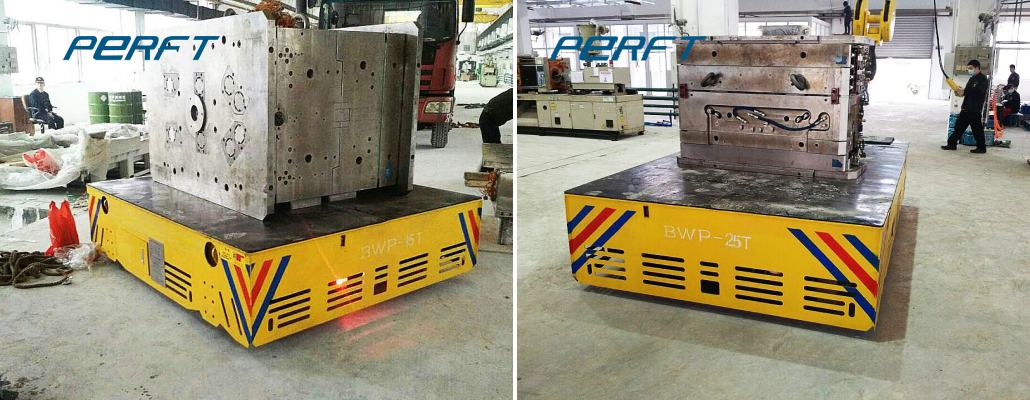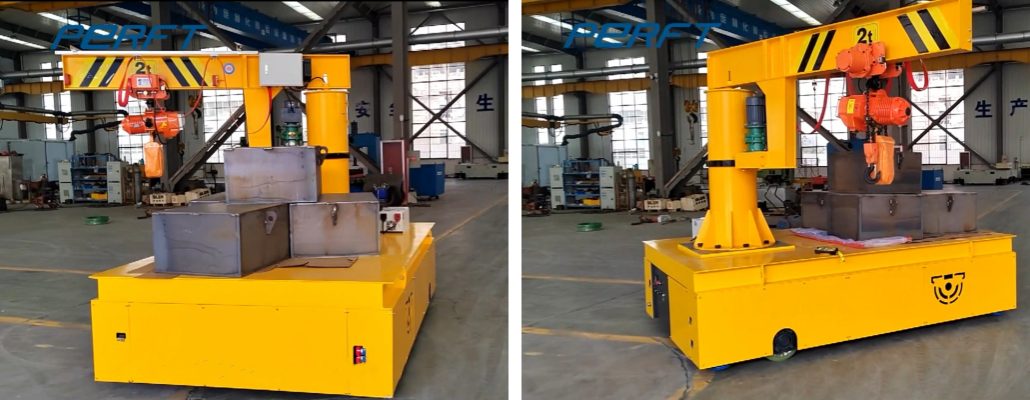Navigation Methods
AGV
- Laser navigation uses the laser scanner installed on automated guided vehicle body to scan the reflectors in the surrounding environment, and determines its own position by calculating the time and angle of laser reflection and other information, which can achieve high-precision positioning and navigation, and can flexibly change the running path according to the preset procedures, which is suitable for complex and changing production and logistics scenes.
However, its system cost is relatively high, and the need for careful layout of reflectors in the operating environment, pre-installation, and later maintenance work is more cumbersome.
- Visual navigation uses on-board cameras to capture image information of the operation area, and then uses advanced image recognition algorithms to process these images and identify predefined landmarks, path features, or obstacles, etc., which is used as the basis for navigation decision-making. This navigation method adapts well to the environment and can work in different scene layouts.
However, it is significantly affected by light conditions, environmental complexity, and the accuracy of image recognition algorithms, and navigation accuracy and reliability may decrease in environments with strong light, low light, obscure image features, or frequent scene changes.
- Magnetic stripe navigation is a more traditional way, by laying magnetic stripes on the ground, the magnetic sensor at the bottom of AGV senses the magnetic field of the magnetic stripes to determine the driving path.
The advantages are a simple principle, low cost, and good navigation stability; the disadvantage is that the path change is not flexible enough, and the magnetic stripe needs to be relaid. Metal and other substances can easily interfere with the magnetic stripe, and once it is damaged or covered, it will affect the normal operation of the automated guided vehicle.
20T Trackless Automatic Transport Vehicle Video
RGV
Rail guided vehicle relies primarily on the track for navigation. It operates on a fixed track that has been laid and determines its position and speed on the track through track circuits or other track sensing devices. This navigation method has a very high positioning accuracy because the track strictly limits the travelling path of rail guided vehicle, and its repetitive positioning accuracy can be controlled within a very small range, which can meet the needs of production processes that require high positioning accuracy, such as in high-precision automated assembly production lines, to ensure the distribution and docking of materials. At the same time, due to the operation along the fixed track, RGV’s running stability and speed can usually reach a high level, which can effectively improve the efficiency of material handling.
However, it is less flexible, and once the track is fixed, it is difficult to change it, which means that the production layout needs to be relatively fixed, and if the production line is to be modified or expanded at a later stage, the cost and workload involved in changing the track is huge, which is not very suitable for production environments with frequent adjustment of the layout.

Vehicle Structure
AGV
- Automated guided vehicle body design focuses on flexibility and versatility. In order to be able to travel freely in complex production environments and complete diversified tasks, its external dimensions are usually relatively small and flexible, and it generally adopts the design of independently-driven wheels, commonly three-wheeled, four-wheeled or multi-wheeled structure, and each wheel is equipped with independent drive motors and steering mechanisms, which makes AGVs capable of realising a variety of flexible steering modes such as turning on the spot, curved turns, etc., and the turning radius can be small according to electric transfer cart body design and drive configuration to achieve smaller values. The small turning radius can be achieved according to automated guided vehicle body design and drive configuration to reach a smaller value, so as to travel freely in narrow aisles or crowded work areas.
- AGV is usually equipped with a loading platform or material carrying device, the form of which varies according to the application scenario. For example, it can be a simple flat structure for handling standardised material containers such as pallets and bins, or it can be a customised tooling fixture for handling workpieces with special shapes or specific assembly requirements. In order to adapt to the needs of material handling at different heights, some AGVs are also equipped with lifting mechanisms, which can adjust the height of the loading platform to achieve docking with shelves, workstations, and other equipment at different heights.
- In addition, because AGVs need to operate autonomously without intervention and cope with various environmental conditions, they are equipped with a large number of sensors and control system-related equipment. For example, navigation sensors such as laser scanners and vision cameras are used to sense the surrounding environment and determine their own position; obstacle avoidance sensors such as ultrasonic sensors and infrared sensors are distributed around the vehicle body, which are used to detect obstacles in front, side and rear in real time, so that obstacle avoidance measures can be taken in a timely manner.
- At the same time, there is a communication module for data interaction with the upper control system, receiving task instructions, uploading operational status information, etc., as well as on-board controller for processing and analysing various sensor data, and according to the preset algorithms and logic to control automated guided vehicle’s drive, steering, lifting and other actions.

RGV
- The body structure of RGV is closely designed around the track operation, which has strong rigidity and stability. The body of RGV is usually in the direction of the track in a long strip, the wheels and the track of the high degree of matching, generally using special track wheels, these wheels in the track rolling operation, to ensure that the vehicle driving process of the smoothness and nature of RGV drive mainly has a single-end drive and double-end drive two kinds.
- Single-end drive has a relatively simple structure, with the drive motor installed at one end of rail guided vehicle body, transmitting power to the wheels through a transmission device; double-end drive has drive motors at both ends of rail guided vehicle body, which can provide a stronger power output and is suitable for longer or heavier loads in RGV application scenarios.
- In terms of vehicle structure, as there is no need to consider the complex free steering problem, the wheel layout of RGV is relatively fixed, usually two or more sets of wheels are arranged along the direction of the track, in order to enhance the support and stability of rail guided vehicle body when running on the track.
